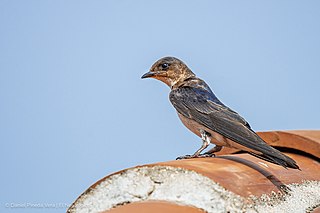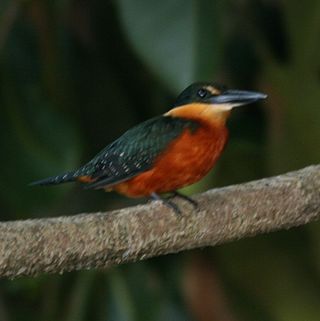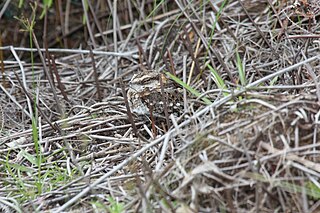
The pied kingfisher is a species of water kingfisher widely distributed across Africa and Asia. Originally described by Carl Linnaeus in 1758, it has five recognised subspecies. Its black and white plumage and crest, as well as its habit of hovering over clear lakes and rivers before diving for fish, make it distinctive. Males have a double band across the breast, while females have a single broken breast band. They are usually found in pairs or small family groups. When perched, they often bob their head and flick up their tail.

The rufous-browed peppershrike is a passerine bird in the vireo family. It is widespread and often common in woodland, forest edge, and cultivation with some tall trees from Mexico and Trinidad south to Argentina and Uruguay.

The copper-rumped hummingbird is a species of hummingbird in the "emeralds", tribe Trochilini of subfamily Trochilinae. It is found in Tobago, Trinidad, Venezuela, and possibly Grenada.

The grey-breasted martin is a large swallow from Central and South America.

The rufous-breasted hermit or hairy hermit is a hummingbird that breeds from Panama south to Bolivia, and on Trinidad, Tobago and Grenada. It is a widespread and generally common species, though local populations may change in numbers and disappear altogether in marginal habitat.

The scaled pigeon is a large New World tropical dove. It is a resident breeder from southern Mexico south to western Ecuador, southern Brazil, northern Argentina, and Trinidad.

The collared aracari or collared araçari is a near-passerine bird in the toucan family Ramphastidae. It is found from Mexico to Colombia and Venezuela.

The American green kingfishers are the kingfisher genus Chloroceryle, which are native to tropical Central and South America, with one species extending north to south Texas.

The Amazon kingfisher is a species of "water kingfisher" in subfamily Cerylinae of family Alcedinidae. It is found in the lowlands of the American tropics from southern Mexico south through Central America to northern Argentina.

The American pygmy kingfisher is a species of "water kingfisher" in subfamily Cerylinae of family Alcedinidae. It is found in the American tropics from southern Mexico south through Central America into every mainland South American country except Chile and Uruguay. It also occurs on Trinidad.

The northern carmine bee-eater is a brightly-coloured bird in the bee-eater family, Meropidae. It is found across northern tropical Africa, from Senegal eastwards to Somalia, Ethiopia and Kenya. It was formerly considered to be conspecific with the southern carmine bee-eater which has a carmine coloured throat rather than the blue throat of the northern species.

The collared kingfisher is a medium-sized kingfisher belonging to the subfamily Halcyoninae, the tree kingfishers. It is also known as the white-collared kingfisher, black-masked kingfisher or mangrove kingfisher. It has a wide range extending from the Red Sea across southern Asia to Polynesia. A number of subspecies and subspecies groups have been split from this species including the Pacific kingfisher, the islet kingfisher, the Torresian kingfisher, the Mariana kingfisher, and the Melanesian kingfisher.

The green-and-rufous kingfisher is a species of "water kingfisher" in subfamily Cerylinae of family Alcedinidae. It is found in the American tropics from Nicaragua to Panama and in every mainland South American country except Argentina, Chile, and Uruguay.

The glittering-throated emerald is a species of hummingbird in the "emeralds", tribe Trochilini of subfamily Trochilinae. It is found in Bolivia, Brazil, Colombia, Ecuador, the Guianas, Peru, Trinidad and Venezuela.

The racket-tailed coquette is a species of hummingbird in the family Trochilidae native to northeastern South America.

The white-tailed nightjar is a species of nightjar in the family Caprimulgidae. It is found in the tropic regions of Central and South America.

The short-tailed nighthawk is a species of nightjar in the family Caprimulgidae. It is found in Mexico, in every Central American country except El Salvador, in Trinidad and Tobago, and in every mainland South American country except Chile and Uruguay.

The azure gallinule is a species of bird in subfamily Rallinae of family Rallidae, the rails, gallinules, and coots. It is found in Argentina, Bolivia, Brazil, Colombia, Ecuador, French Guiana, Guyana, Paraguay, Peru, Suriname, Trinidad and Tobago, and Venezuela.

The green-barred woodpecker or green-barred flicker is a species of bird in subfamily Picinae of the woodpecker family Picidae. It is found in Argentina, Bolivia, Brazil, Paraguay and Uruguay.

The Buru green pigeon is a pigeon in the genus Treron. It is found in the forests of Buru in Indonesia. Many authorities split the species from the pompadour green pigeon complex.























